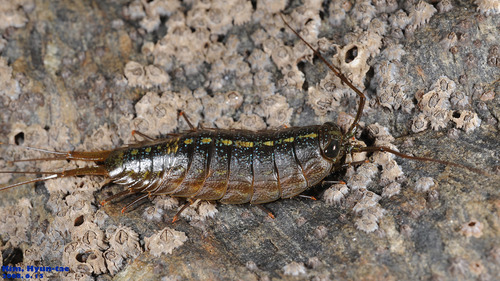
What is Ligia exotica? A sea slater you say?
Table of Contents
In fact, “sea slater” is a common name that refers to species belonging to the genus Ligia. In other words, L. exotica is a sea slater, but it is not the only sea slater: there are at least 54 species of Ligia in the world[2]! Many of them closely resemble one another and it can be difficult to distinguish one species from the next. Some other common names for L. exotica are wharf roach and sea cockroach.
Roach??? It’s a cockroach???
NO! This is one of the most common misunderstandings about L. exotica and other Ligia species! Because of their tiny size, nocturnal habits and skittish nature, people seldom get more than a glimpse of them before they scurry away into hiding. As a result, few people know much about Ligia – they are difficult to observe.Here are 4 interesting facts about L. exotica and its fellow sea slaters: read on to find out more!
1. Sea slaters are more closely related to crabs than cockroaches!
While sea slaters (Ligia spp.) do behave a little like “cockroaches of the sea”, it belongs to the crustacean family, together with crabs and prawns! Sea slaters are NOT insects – they are isopods, characterized by seven pairs of legs, seven thoracic segments and six abdominal segments. Insects only have six pairs of legs and a three-part body: the head, thorax and abdomen! (See sections on Anatomy and Taxonomy)
2. Don’t try to eat it though, it might taste like very strong urine.
Despite its distant relation with certain marine animals we associate with delicious seafood (read: crab, prawn, lobster), stir-frying sea slaters in chilli sauce is far from likely to yield a pleasing rendition of chilli crab. While no one has documented the consumption of Ligia spp., people have tasted woodlice, an isopod of the same suborder Oniscidea, and sworn never to eat it by choice again as “basically it tastes of strong urine” [3]. Nasty.
3. They do not bite humans, as they feed on dead matter such as detritus.
So they would not bite you unless you are dead (bad joke). And anyway, sea slaters are extremely terrified of humans and run away when approached (See section on Behaviour). They would be too timid to bite anyone.
4. There is a Pokémon version of the sea slater – “Wimpod”.
There exists a generation VII pokémon bearing close resemblance to Ligia spp., called Wimpod: "Wimp" + "pod". It is slated to be available in Pokémon Sun and Moon, Nintendo 3DS game titles to be released on 18 November 2016 [4].
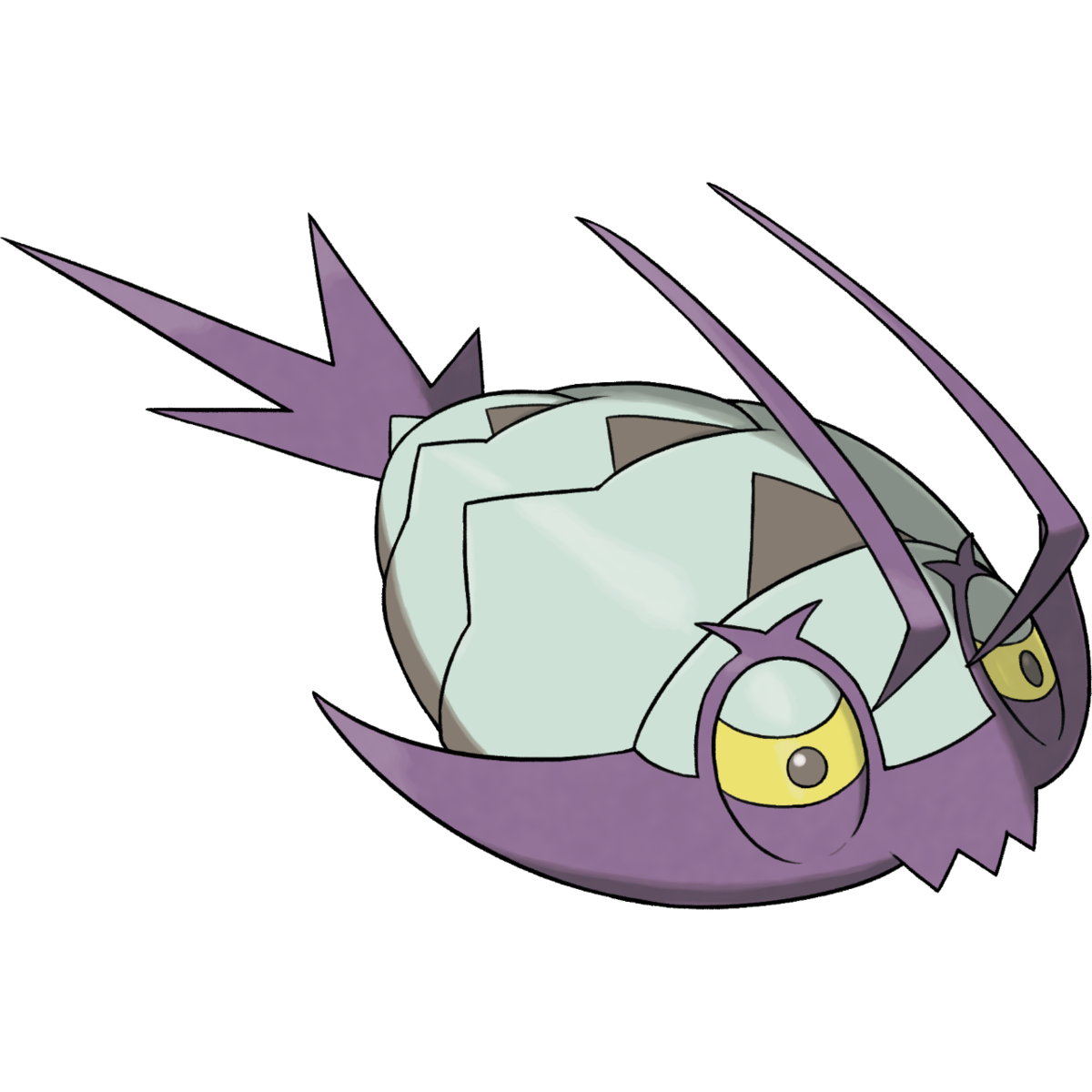
[5] Official art by Ken Sugimori, contributed under fair use.
Interestingly, this is not the only video game to adapt sea slaters into their virtual worlds. In the Nintendo 3DS game Animal Crossing: New Leaf, the species Ligia exotica actually makes an appearance, starring as itself! Though the in-game behaviour of the isopod mirrors that in reality, the game’s wiki page erroneously refers to it as an “insect” …[6]
 [7] Screenshot of L. exotica as it appears in the insect encyclopaedia in the game. Used in accordance with Fair Use guidelines.
[7] Screenshot of L. exotica as it appears in the insect encyclopaedia in the game. Used in accordance with Fair Use guidelines.Trivia aside, maybe it’s time to ask more important questions…
What kinds of sea slaters can be found in Singapore?
Studies have been limited in this regard, as identification of Ligia spp. usually require close examinatino and expert opinion. Ligia exotica has been recorded on Singapore's shores in several studies [8] [9] . Unconfirmed records of L. hawaiiensis exist (sometimes spelled L. hawaiensis) [10], while in a web database that documents distribution of invertebrate species worldwide, only 2 Ligia species are listed: L. exotica and L. vitiensis [11].That said, L. exotica is certainly found in Singapore and there exists at least 2 species of Ligia on our shores. The next time you visit a beach and see some sea slaters scurrying away hurriedly, you can be sure that it is not L. hawaiiensis, as they are mangrove dwellers [12] [13]. You are probably looking at L. exotica or L. vitiensis. It can be difficult to differentiate between the 2 Ligia as L. vitiensis has been noted as "insufficiently described" - there is not enough information or research done on it [14].
Where can I find L. exotica in Singapore?
Ligia exotica can be found in intertidal zones, especially during low tide. Beaches, breakwaters, marine debris and any structure bordering the sea that provides high humidity environments are places they frequent!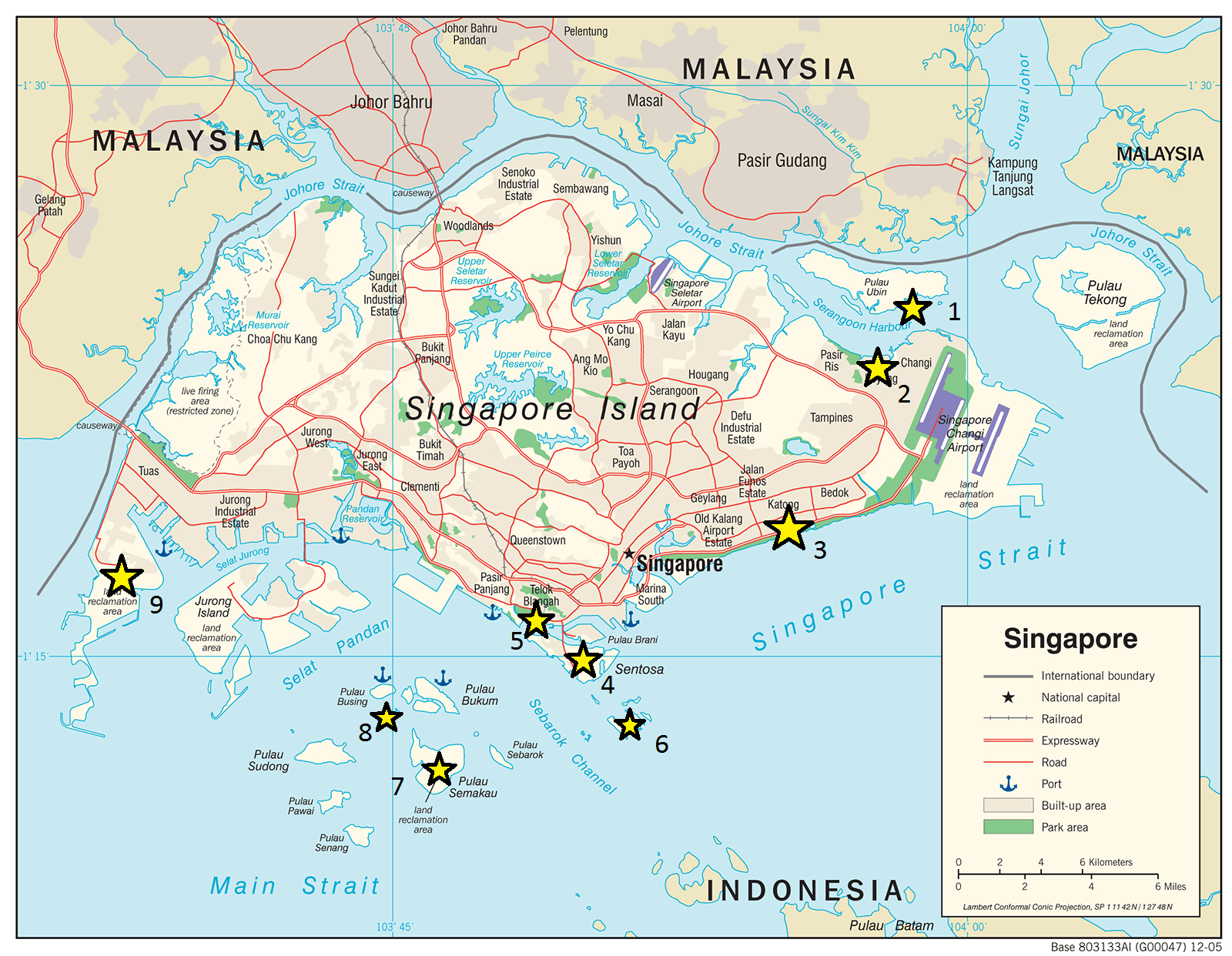
Now you have all the information you need to find and observe L. exotica and its sea slater buddies! But wait... what does its name L. exotica mean? What does it eat? How do I know if I am indeed looking at L. exotica and not something else? Well, if you find yourself asking these questions, read on to discover more intriguing facts about this unique animal!
Everything you need to know about L. exotica
What does its name mean?
Belonging to the Ligiidae family, Ligia exotica is a woodlouse-like isopod. The name isopod originated from greek ἴσος (iso=same) and πούς (pod=foot) [16], a reference to the uniform pairs of legs found in each segment of an isopod (see section on Anatomy).Its common names include: Sea slater, sea cockroach, wharf roach [17], though it can be pretty confusing as these names are used for other Ligia species as well.
Etymology
Ligia exotica is a scientific name: Ligia, denoting that it belongs to the family Ligiidae. The specific epithet “Exotica” likely means “exotic”, probably a reference to the species being relatively unknown to the locality where it was initially described by Polydore Roux in Marseilles, France [18] (See also Nomenclature).Synonyms
Synonyms are scientific names recognized to be referring to the same species and are considered to have be superseded. All these names refer to the same species, L. exotica [19] [20].Ligia gaudichaudii (Milne Edwards, 1840)
Ligia grandis (Perty, 1834)
Ligia olfersii (Brandt, 1833)
Ligia filicornis (Budde-Lund, 1893)
How does its body look like?
Ligia exotica can grow up to 4cm in length; female individuals are typically smaller than males. Typical of an isopod, it has a dorsoventrally flattened body which is wider than it is deep [21]. As an isopod, its body plan follows that of a regular isopod as shown below: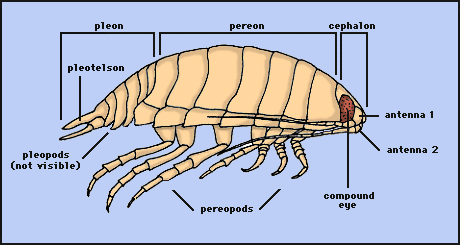
All information in this section are from [22] and [23] unless stated otherwise.
There are 3 main sections: the head fused with the first thoracic segment, the remaining thorax and abdomen. There are 7 thoracic segments which constitute the pereon. Each segment in the pereon is called a pereonite (sometimes also called pereomere). 5 segments, each singular segment termed pleonite, along with a 6th pleonite fused with a telson to form a pleotelson, form the abdomen. The 2 eyes are compound and sessile; stalking is absent. The mouthparts consists of a pair of maxillipeds and one pair of mandibles. The carapace is mostly absent, reduced to only cover its head. Each pereonite has a pair of uniramous legs attached, that is, legs that are a single series of segments attached end to end. True to its isopoda nature ( isopod ="same-foot"), the legs of L. exotica are uniform in size and morphology.
Here come the differences of L. exotica and the typical isopod body plan!
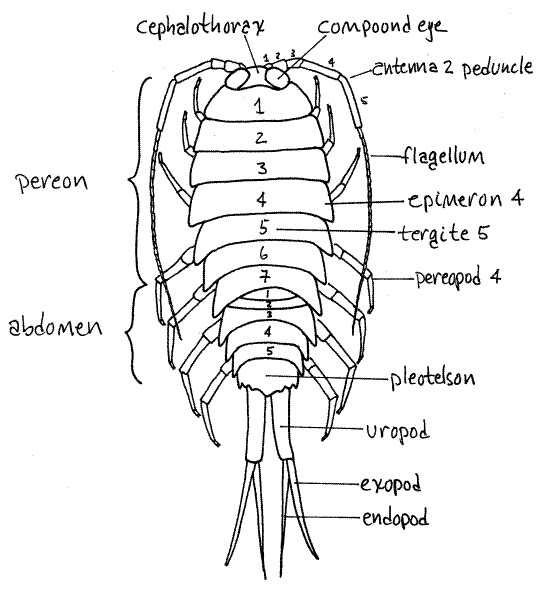
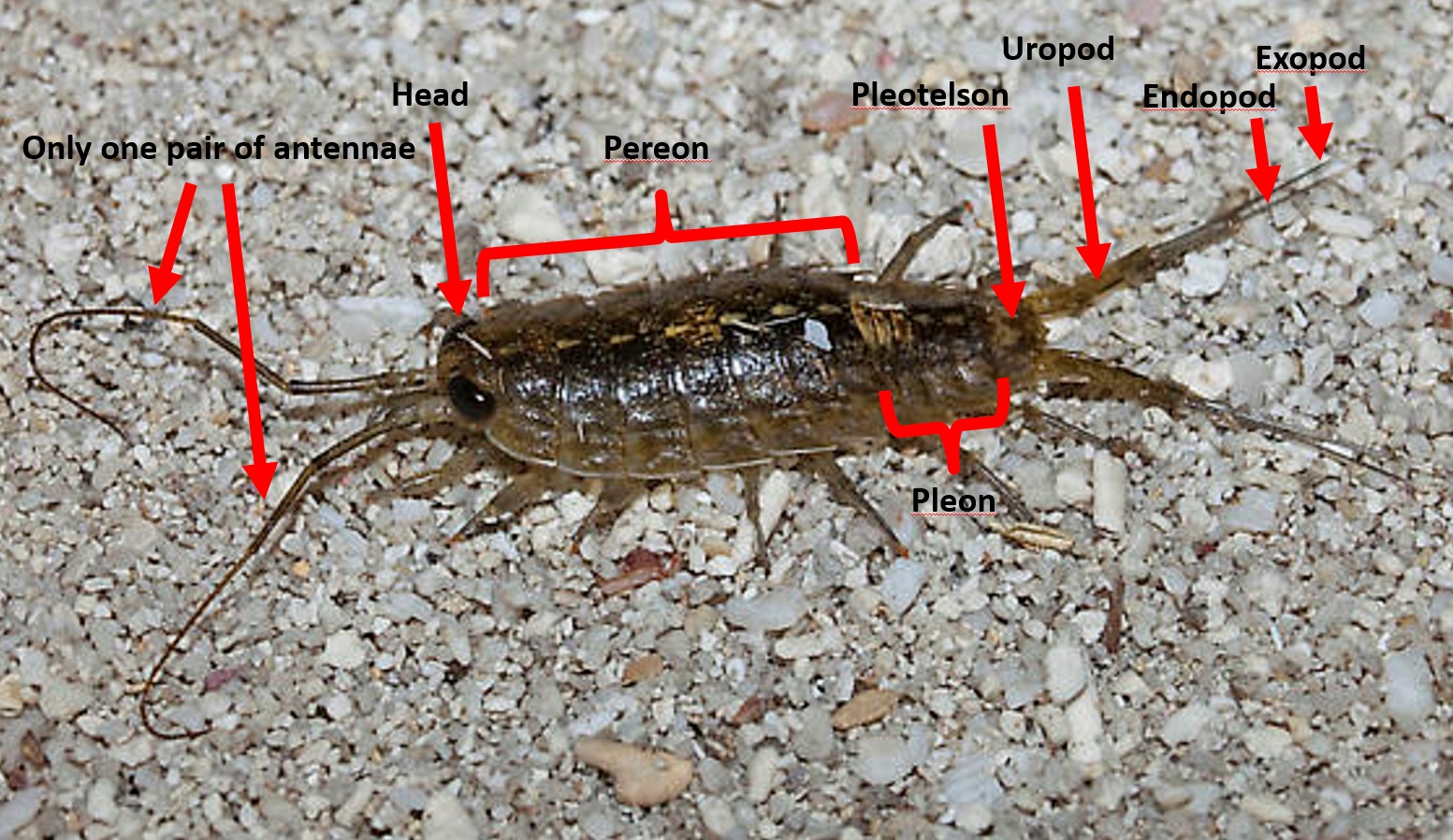
In L. exotica, attached to the pleotelson are 2 uropods that are visible from dorsal view, forming a fork. Each uropod has another fork-like extension, called the endopod and exopod [26] . Instead of 2 pairs of antennae, L. exotica only has one pair - the second pair; the first pair has evolved to become vestigial. As a special adaptation to life on land, L. exotica has membranous gills are attached to the first five pleonites and exopods, resembling lungs and serving a similar function for respiration on land.
In males, the reproductive structure penes are located at the 7th pereonite, while in the females the gonopores are located at the 6th pereonite.
Its anus is a slit under its pleotelson.
Distinguishing L. exotica from other sea slaters
Ligia exotica are usually greyish-brown, with pale brown appendages, speckled with brown spots. Its surface is moderately roughly granulate [27].
It can be easily confused with L. oceanica, a species originally from Europe but now widely distributed, particularly on the Atlantic Coast of USA, from Rhode Island to Maine. Ligia oceanica, however, is grey or olive green in colour and inhabits temperate waters unlike L. exotica, which typically inhabits warmer waters [23].
Other similar looking species are L. occidentalis (diffused from Central America up to Central California) and L. baudiniana (from Brazil to South Florida and also Bermuda and the Carribean) [26]. But as sometimes differences tend to be minor and require microscopic examination, it is difficult without expert opinion to be certain [27]!
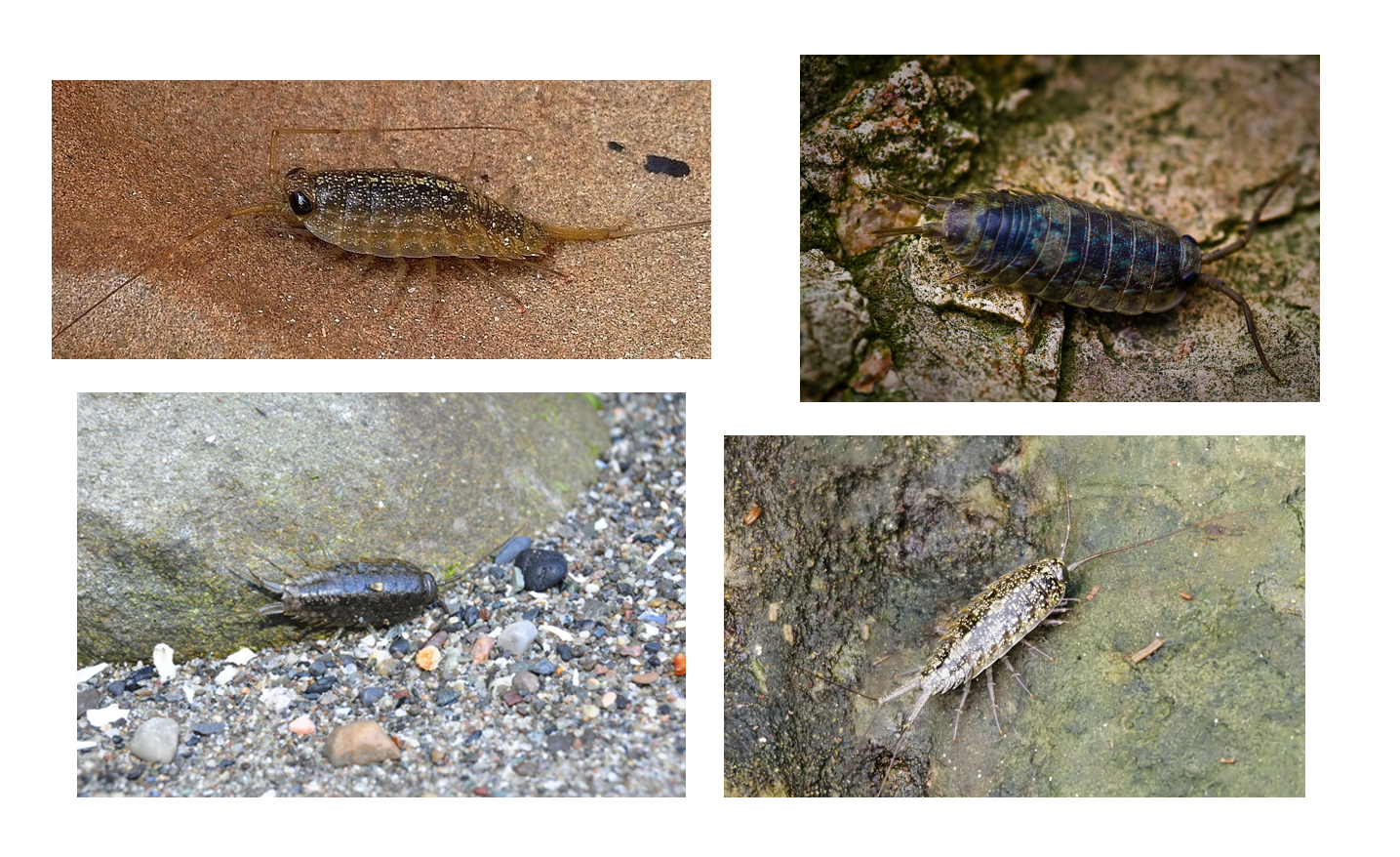
[29] L. oceanica, photo copyright © D. Azuma, 2005, used under Creative Commons (CC BY 2.0).[30] L. baudiniana, photo copyright © H. Hillewaert, 2009, used under Creative Commons (CC BY 4.0).[31] L. occidentalis, photo copyright © A. Simon, 2016, used under Creative Commons (CC BY 4.0).
Distribution around the world: a cosmopolitian species!
While this species is commonly believed to be native to the coasts of Western Europe and Mediterranean Sea, it was considered exotic when discovered in France (hence the name “exotica”). This led to the idea that it could be native to the Pacific and Indian Oceans [32]. Nowadays the species can be found in most parts of the world, inadvertently introduced through shipping activities and other forms of artificial transport. It is widely diffused in America and South-East Asia (it is possible to find it also in Singapore) [33] . In North America, it can be found from Florida to New Jersey, in coastal Texas and it has also been recorded in Hawaii.Feeding
Ligia exotica is a herbivore, typically feeding on brown and green algae and diatoms that grow on rocks and walls within the high intertidal [34]. It has also been recorded behaving as a scavenger, thriving on a diet that includes detritus and plant debris [35]. This makes L. exotica an important contributor to decomposition: an essential ecological function for nutrient cycling!Behaviour
They usually live in large dioecious colonies: 50 individuals can easily be found together in the same site [26].They tend to be very shy and skittish. Ligia exotica is nocturnal: preferring to hide in shade during the day and venturing out to forage and scavenge. Watch this video to see the animal in action!
フナムシダァ~ Ligia exotica, uploaded by user kazuo0831, Used in accordance with the Fair Use guidelines.
Ligia exotica is a potential prey for shorebirds, even though very little or no official information is available.
Even though this is an invasive species (especially in the American continent) no studies has been conducted on the consequences on native species. Ligia exotica is often a dominant high intertidal invertebrate but very little information is available on the impact of the availability of food for other native species as well as the economic impact [26]. It is also possible that L. exotica is at this point naturalized throughout many of the areas where it has been introduced.
Life cycle and reproduction
The information about the biology of this species is limited, though closely related species have been studied better and might be applicable to L. exotica.The average lifespan is about 2 years; sexual maturity is reached at 1 year of age. The reproductive season in the southern hemisphere lasts from September/October to May/June, while in eastern North America the season is in April, with an average number of 80 eggs laid on a single reproductive event [36]. Females are iteroparous (capable of having more than one reproductive cycle in a lifetime) and can have more reproductive events per year. The fertilization is internal and outcrossing, meaning that the union of the two occurs inside the body of the parent, and the ovum of the female is fertilized with the spermatozoa of the male. Once the eggs are fertilized, they are carried by the female outside their body by specialized appendages. This feature is called ovigery.
The typical development time of the eggs is 28 days and is normally a direct development, but it seems that some other species of the same genus originate as free-swimming larvae [23].
Taxonomy and Systematics
Taxonavigation
Kingdom: AnimaliaPhylum: Arthropoda
Class: Malacostraca
Subclass: Eumalacostraca
Superorder: Peracarida
Order: Isopoda
Suborder: Oniscidea
Family: Ligiidae
Genus: Ligia (Fabricius, 1798)
Species: Exotica (Roux, 1828)
Nomenclature
Ligia exotica was originally described by Polydore Roux in his book Crustacés de la Méditerranée et de son littoral (crustaceans of the Mediterranean and its littoral zone) in 1828. It was named in French as Lygie exotique, which translates to the Latin name.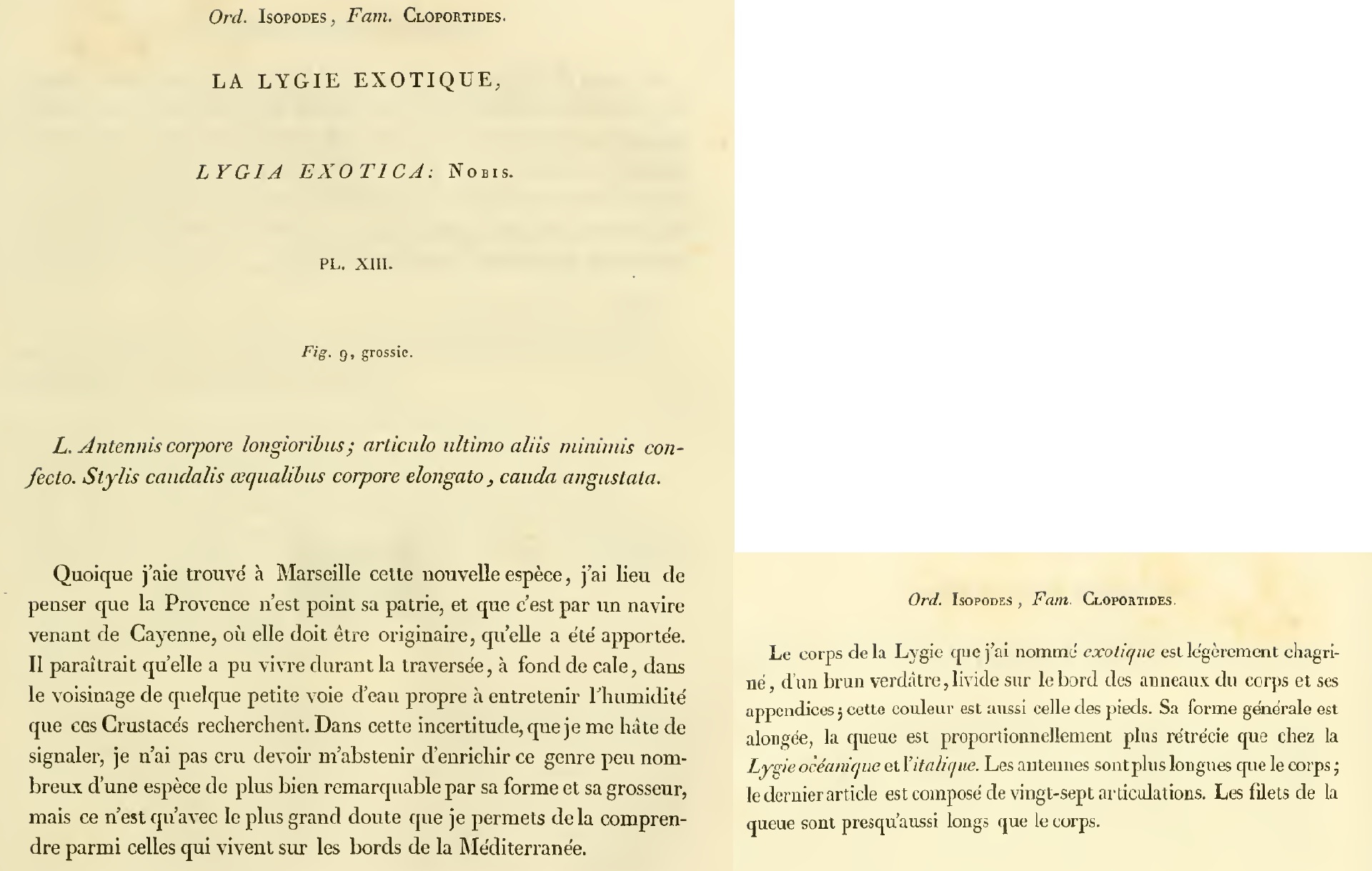
Type specimen
The type specimen could not be found online. There exists a paratype: a specimen that helps to define the species but is not the specimen from which the original species description was made. This paratype was recorded on Madagascar on the 1st of January, 1967 by Roman, M. L., and stored with the Natural History Museum of London [37].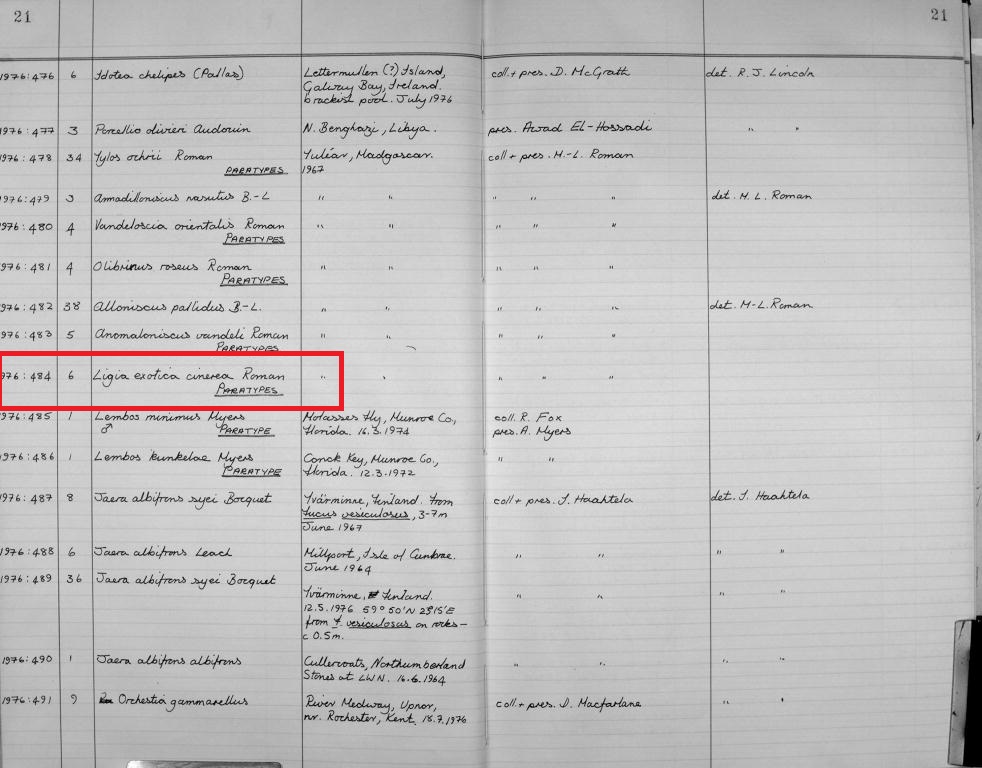
Phylogeny
L. exotica falls under the suborder Oniscidea, which is currently considered to be a monophyletic clade, well-supported by numerous apomorphies [38]. It is the only group within Crustacea to have successfully exploited terrestrial environments. Ligiidae are argued to be the most primitive form of Oniscidea, as the shoreline and high-humidity loving members of this family appear to represent the transitionary phase between aquatic and terrestrial isopoda [39].
Phylogenetic relationships between the major isopoda groups is still pending research: their basal relationship as been disputed over the years (Figure 1). However, fossil records have suggested that Oniscidea has Carboniferous origins, diverging from an aquatic ancestral lineage circa 299 Ma ago [40] (Figure 2). Knowledge regarding this ligiid-like ancestral group remains extremely limited, especially so because it relies heavily on fossils, which are very rare.
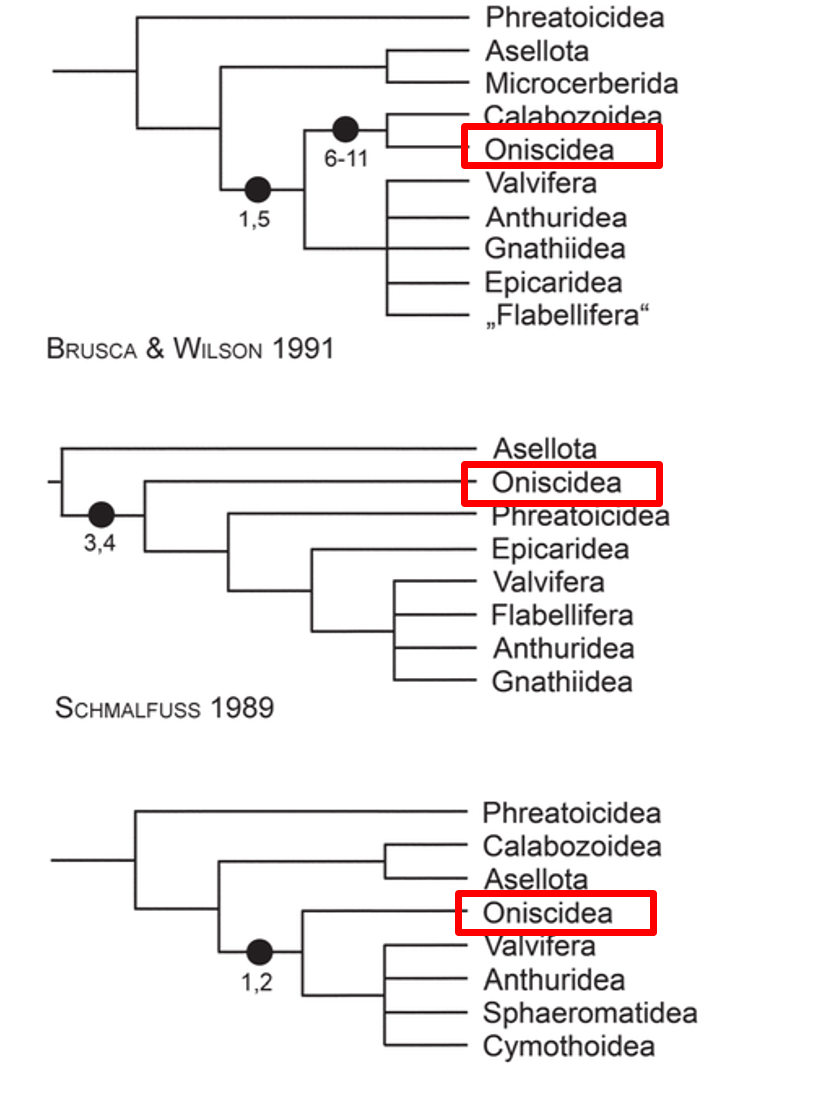
Figure 1: Adapted from Schmidt (2008), revisions of phylogenetic trees for the 8 well-established (monophyletic) isopoda clades over the years. Annotations in red by Tan Yen Yi.
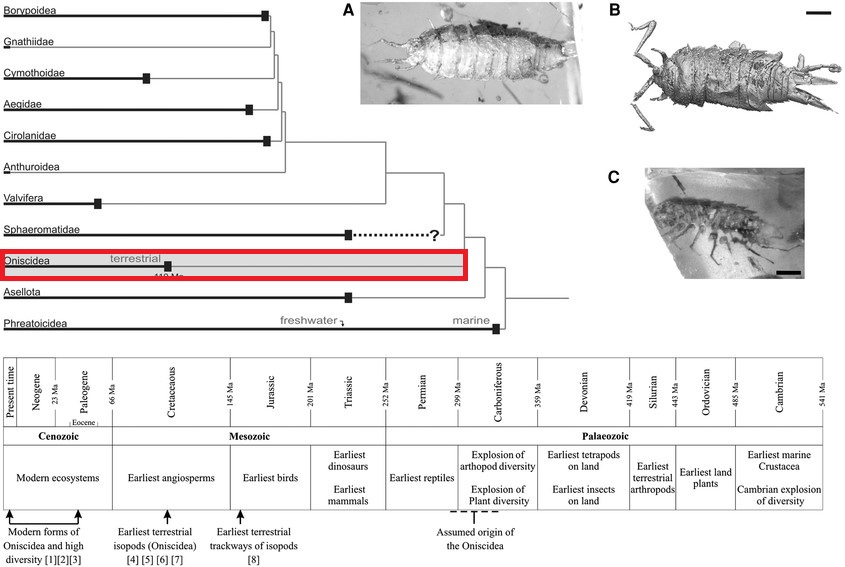 Figure 2: From Broly, Deville and Maillet (2013), a synthetic phylogenetic tree constructed based on fossil records and recent morphological studies [41]. Branch lengths are proportional to time. Annotation in red by Tan Yen Yi.
Figure 2: From Broly, Deville and Maillet (2013), a synthetic phylogenetic tree constructed based on fossil records and recent morphological studies [41]. Branch lengths are proportional to time. Annotation in red by Tan Yen Yi.Phylogeny of L. exotica is not well studied, though the phylogeny of its genus has been documented. In a paper by Wilson, G. D. F., 2009, the phylogenetic position of Isopoda within the superorder Pericarida was investigated.In Figure 3 - By analyzing 18S rDNA genes, indel costs were calculated and a parsimony tree generated. The result was the separating of many clades, as indicated by multicoloured branches. Branch lengths are proportional and generated through implied alignment prior to analysis. The genus Ligia was represented by L. oceanica and L. italica as annotated in red.
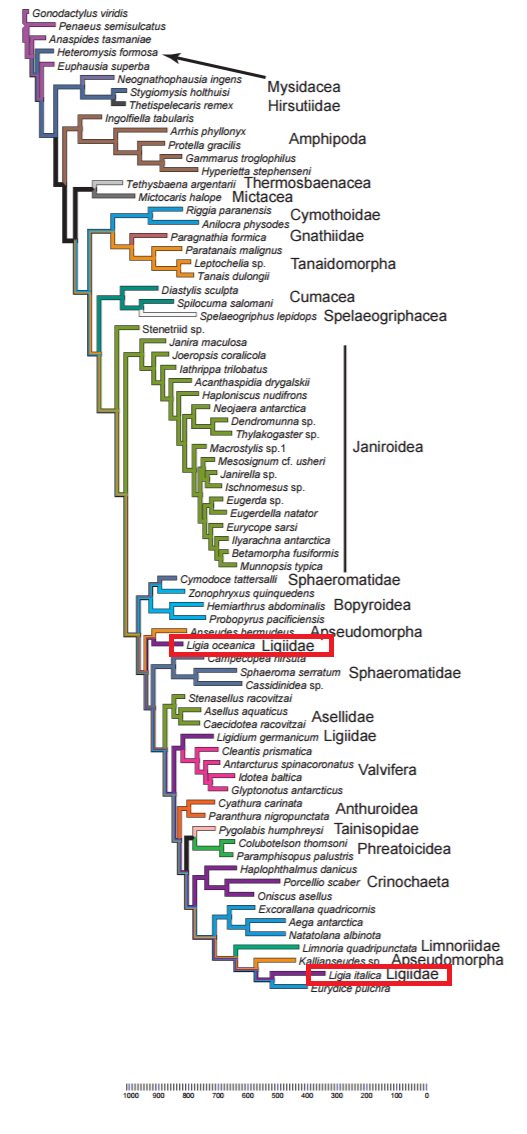
In Figure 4 - There seems to be more predictable results when morphological and taxonomic information are considered, as clades are not split as haphazardly as in Figure 3.
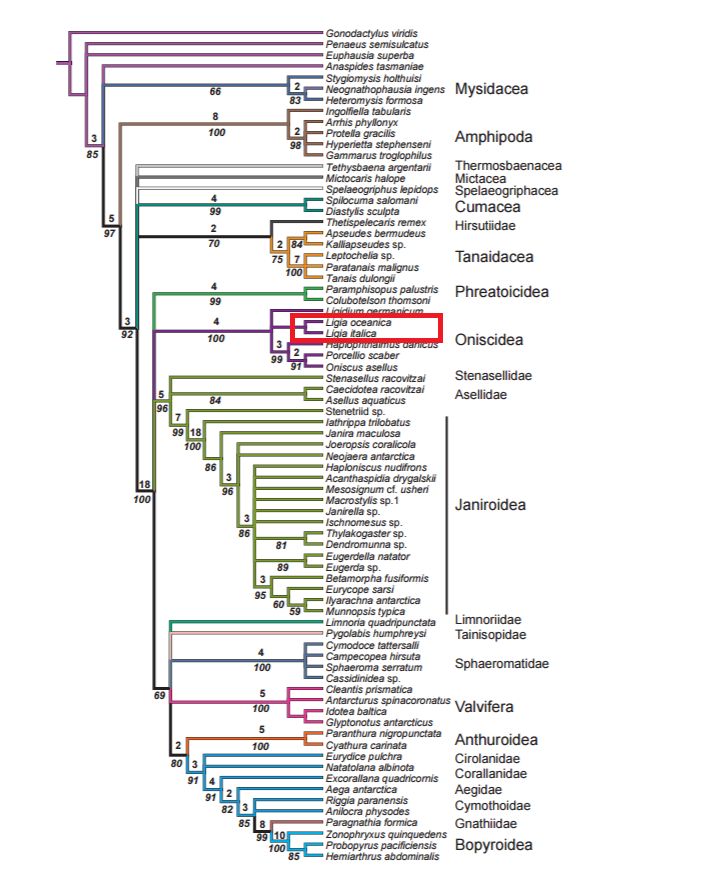
Figure 4: Consensus tree of length 711 constructed based on maximum parsimony, based on taxa information and morphological data. Branch node stability was calculated through Jackknife, with 33% deletion per replicate for 1000 replicates (values in italics below each node) and Bremer support values about each node. Bremer support values lower than 2 are omitted. Annotations in red by Tan Yen Yi.
The clade formed by the suborder Oniscidea, in which Ligia are placed, has very strong nodal support (100 Jackknife value). However, the branch separating L. oceanica and L. italica is missing its Bremer support value, indicating that the value was low and the node is unstable. There is a need for more studies to confirm if these 2 species have to be reconsidered. Also, considering that Ligia spp. are very poorly studied (this is one of the few studies that compare Ligia to other isopoda families and orders), more studies should be conducted to shed more insight on the phylogeny of this genus.
References[1] "Photo 1568189," by Kim Hyun-Tae. iNaturalist.org. URL: http://www.inaturalist.org/photos/1568189 (accessed on 10-11-2016).[2] "Taxonomy for Ligia”. Insectoid.info. URL: http://insectoid.info/malacostraca/isopoda/ligiidae/ligia_genus/ (accessed on 22-11-2016).[3] "How now, sow bug?” by Patricia Gadsby, August 1999. URL: https://msvictorialin.wikispaces.com/file/view/sow-bug-article.pdf (accessed on 22-11-2016).[4] "Wimpod," by Bulbapedia. URL: http://bulbapedia.bulbagarden.net/wiki/Wimpod_(Pokémon) (accessed on 10-11-2016).[5] "Wimpod," by Ken Sugimori. Bulbapedia. URL: http://bulbapedia.bulbagarden.net/wiki/Wimpod_(Pokemon) (accessed on 10-11-2016).[6] "Wharf Roach,” Nookipedia, the Animal Crossing Wiki. URL: https://nookipedia.com/wiki/Wharf_Roach (accessed 22-11-2016).[7] "Wharf Roach,” by user Platinum Lucario. URL: https://nookipedia.com/w/images/e/ea/Wharf_roach.png (accessed 22-11-2016).[8] Bruce, N. L., & Wong, H. P. S., 2015. An overview of the marine Isopoda (Crustacea) of Singapore. Raffles Bulletin of Zoology. Supplement, 31, 152-168.[9] Ng, P. K., Sivasothi, N., Tan, K. S., Lim, K. K., & Murphy, D. H., 1999. A guide to the mangroves of Singapore II. Singapore Science Centre, 168.[10] Ng, P. K., Sivasothi, N., Tan, K. S., Lim, K. K., & Murphy, D. H., 1999. A guide to the mangroves of Singapore II. Singapore Science Centre, 168.[11] "Species overview – Checklist for Ligiidae in Singapore.” Insectoid.info. URL: http://insectoid.info/checklist/ligiidae/singapore/ (accessed on 22-11-2016).[12] Englund, R. A., 2002. The loss of native biodiversity and continuing nonindigenous species introductions in freshwater, estuarine, and wetland communities of pearl harbor, oahu, hawaiian islands.Estuaries, 25(3), 418-430.[13] Ng, P. K., Sivasothi, N., Tan, K. S., Lim, K. K., & Murphy, D. H., 1999. A guide to the mangroves of Singapore II. Singapore Science Centre, 168.[14] Zoological Society of London, 1922. Proceedings of the Zoological Society of London. Zoological Society of London, part 3-4, 689. BHL database, URL: http://www.biodiversitylibrary.org/page/32281991 (accessed on 22-11-2016).[15] "Singapore Political Map". URL: http://singaporemap.facts.co/singaporemapof/singaporemap.php[16] "Isopod," definition by Merriam-Webster. URL: http://www.merriam-webster.com/dictionary/isopod (accessed on 10-11-2016).[17] Gosner, K. L., 1971. Guide to identification of marine and estuarine invertebrates: Cape hatteras to the bay of fundy. New York: Wiley-Interscience.[18] Roux, P. (Jean Louis Florent Polydore), 1828. Crustacés de la Mediterranée et de son littoral, decrits et lithographies par lui- meme. Annales des Sciences Naturelles 16:Paris et Marseille.[19] "Ligia exotica Roux, 1828.". World Register of Marine Species. URL: http://www.marinespecies.org/aphia.php?p=taxdetails&id=148661 (accessed on 22-11-2016).[20] "Ligia exotica." Insectoid.info. URL: http://insectoid.info/malacostraca/isopoda/ligiidae/ligia_exotica/ (accessed on 22-11-2016).[21] Naylor, E., 1978. British Marine Isopods: Keys and Notes for the Identification of the Species (2nd ed.), 2.[22] "Isopoda," by Brusca, R., 1997. The Tree of Life Web Project. URL: http://tolweb.org/Isopoda (accessed on 22-11-2016).[23] "Ligia exotica," by Fox, R., 2006. Invertebrate anatomy online. URL: http://lanwebs.lander.edu/faculty/rsfox/invertebrates/ligia.html (accessed 10-11-2016).[24] Van Name, W. G., 1936. The American land and fresh-water isopod Crustacea. Bulletin of the American Museum of Natural History, 71:1-535.[25] "Isopod IMG_8830 - Ligia exotica (male)," by Steve Nanz. Bugguide. URL: http://bugguide.net/node/view/514361/bgpage (accessed on 22-11-2016).[26] "Ligia exotica: Wharf Roach," by Smithsonian Marine Station. URL: http://www.sms.si.edu/IRLSpec/Ligia_exotica.htm (accessed on 10-11-2016).[27] Zoological Society of London, 1922. Proceedings of the Zoological Society of London. Zoological Society of London, part 3-4, 693. BHL database, URL: http://www.biodiversitylibrary.org/page/32281998#page/297/mode/1up (accessed on 22-11-2016).[28] "Ligia exotica," by Azuma, D., 2011. Wikipedia commons. URL: https://en.wikipedia.org/wiki/Ligia_exotica#/media/File:Ligia_exotica.jpg (accessed on 22-11-2016).[29] "Ligia oceanica," by Robinson, M., 2005. Flickr. URL: https://www.flickr.com/photos/66176388@N00/2904455895/ (accesssed on 22-11-2016).[30] "Ligia baudiniana," by Hillewaert, H., Wikipedia commons. URL: https://en.wikipedia.org/wiki/Ligia_baudiniana#/media/File:Ligia_baudiniana.jpg (accessed on 22-11-2016).[31] "Ligia occidentalis," by Simon, A., 2016. iNaturalist. URL: http://www.inaturalist.org/observations/3540153 (accessed on 22-11-2016).[32] Roman, M. L., 1977. Les oniscoides halophiles de Madagascar (Isopoda, Oniscoidea). Beaufortia. 26(334), 107–151.[33] Ng, P. K., Corlett, R., & Tan, H. T. (Eds.). 2011. Singapore biodiversity: an encyclopedia of the natural environment and sustainable development. Editions Didier Millet.[34] Schultz, G. A., 1977. Terrestrial isopod crustaceans (Oniscoidea) from St. Catherines Island, Georgia. Georgia Journal of Science, 35, 151-158.[35] Eldredge, L. G., & Smith, C. M. (Eds.). 2001. A guidebook of introduced marine species in Hawaii. Bishop Museum and the University of Hawai'i.[36] Lopes, E. R., Blasina, J. R., Dumont, L. F., & D'Incao, F., 2006. Reproductive biology of Ligia exotica (Crustacea, Isopoda, Ligiidae) in Rio Grande, Rio Grande do Sul State, Brazil. Iheringia. Série Zoologia, 96(1), 5-12.[37] "Ligia exotica Roux, 1828," by Global Biodiversity Information Facility. URL: http://www.gbif.org/occurrence/1055322920 (accessed on 22-11-2016).[38] Schmidt, C., 2008. Phylogeny of the terrestrial Isopoda (Oniscidea): a review. Arthropod Systematics & Phylogeny, 66(2), 191-226.[39] Carefoot, T. H., & Taylor, B. E., 1995. Ligia: a prototypal terrestrial isopod. Crustacean, (9), 47-60.[40] Broly, P., Deville, P., & Maillet, S., 2013. The origin of terrestrial isopods (crustacea: Isopoda: Oniscidea). Evolutionary Ecology, 27(3), 461-476.[41] Wilson, G. D. F., 2009. The phylogenetic position of the Isopoda in the Peracarida (Crustacea: Malacostraca). Arthropod Systematics & Phylogeny, 67(2):159–198.